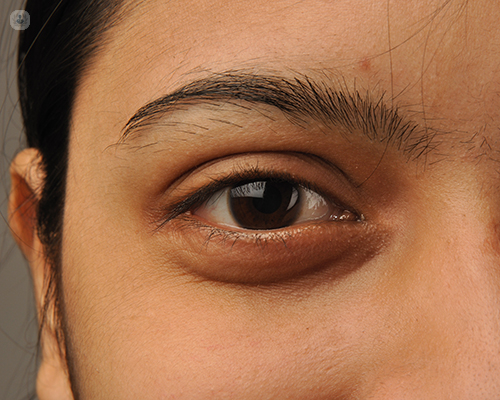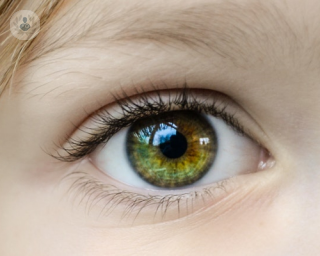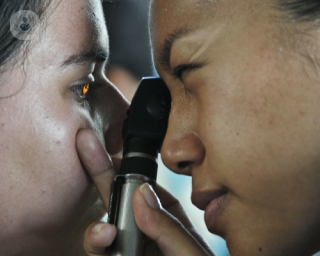Ocular melanoma
Dr Gabriella De Salvo - Ophthalmology
Created on: 11-13-2012
Updated on: 10-26-2023
Edited by: Conor Lynch
What is ocular melanoma?
Ocular melanoma is a form of cancer that affects melanin, the cells responsible for producing pigment in the body. Although this disease is rare, it is the most common type of cancer that affects the eyes.
It can affect all parts of this organ, especially hard-to-access parts that make detection difficult. This is why it is essential to have regular eye examinations.
What is the outlook for patients with ocular melanoma?
The prognosis for a person affected by ocular melanoma will be different depending on the characteristics of the type and location of the tumour and the stage of melanoma progression. If the cancer is diagnosed before it reaches an advanced stage, the probability of survival is around 100 per cent.. However, if the melanoma is diagnosed at an advanced stage, this percentage decreases exponentially. It is precisely for this reason that early detection is necessary through regular check-ups with the ophthalmologist.
What are the main symptoms of ocular melanoma?
In some cases, ocular melanoma may not have any specific cause or produce any symptoms. However, in other cases, the following signs and symptoms may appear:
- A black spot in the iris area that gradually gets bigger
- A sensation of flashing lights
- Changes in the shape of the pupil
- Progressive loss of peripheral vision
- Flashes or dust-like specks in your field of vision, also called floaters.
How is ocular melanoma diagnosed?
There are different tests to diagnose this disease. The ophthalmologist may recommend some of the following:
Eye exam: the ophthalmologist will check the outside of your eye for inflamed blood vessels, which may be a symptom of a tumour in the eye. Then, using other devices, they will examine the inside of your eye.
Eye ultrasound: this test uses high-frequency sound waves emitted from a portable, rod-shaped device called a transducer, which reflects images of the eye. The device is placed on the closed eyelid or on the front surface of the eyeball.
Eye angiography: this allows the specialist to see images of the blood vessels in the tumour and surrounding area. With this procedure, a dye is injected into a blood vessel in your arm. The dye reaches the veins of the eye and then a camera with built-in filters detects the dye and takes pictures for several minutes.
Biopsy: sometimes the ophthalmologist may decide to remove a sample of tissue from your eye for analysis. A fine needle is inserted into the eye to remove tissue that is suspected of being cancerous. This is then taken to a laboratory to be tested for ocular melanoma cells.
What causes ocular melanoma?
Researchers acknowledge that the causes of ocular melanoma are not clear. Specialists believe that it manifests itself when errors develop in the DNA of healthy eye cells. These errors allow the mutated cells go on living, whereas they would normally die. The mutated cells concentrate in one of the eyes and lead to ocular melanoma.
Can it be prevented?
It is not 100 per cent certain that ocular melanoma can be prevented. There are theories that indicate that melanomas can develop after prolonged exposure to the sun, but there are no studies that confirm that the two factors are related. Even so, exposure to the sun between 11am and 5pm and not wearing sunglasses can be detrimental to the health of the eye. It is advisable to visit the ophthalmologist at least once a year so that the disease can be detected in its initial phase if it does appear.
How is ocular melanoma treated?
Treatment for ocular melanoma depends on the location and the size of the melanoma, as well as on your preferences and state of health. Sometimes small eye melanomas do not need immediate treatment. As long as the melanoma is small and does not increase in size, your doctor may recommend waiting until growth symptoms are detected.
Surgery: surgery is one of the most common treatments for ocular melanoma. This involves removing part of the eye or removing the eye completely.
Radiation therapy: this technique uses high-powered energy sources, such as protons or gamma rays, to destroy cancer cells. Radiation therapy is used for small to medium-sized ocular melanomas.
Laser treatment: sometimes a laser is used to destroy the melanoma cells. Thermotherapy involves using an infrared laser and is sometimes combined with radiation therapy.
Cold treatment: cryotherapy is used to destroy the cells of smaller ocular melanomas, although this treatment is the least used of all those described.
Which specialist treats it?
An ophthalmologist is the specialist who treats ocular melanoma.




